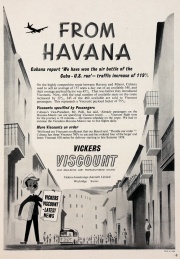Vickers: Viscount








The Vickers "Viscount,", was the first propeller turbine airliner to go into service.
In response to the Brabazon committees' recommendations for a medium-range European airliner, Vickers-Armstrongs produced the Vickers VC2, powered by four propeller-turbine engines.
The Type IIB used Rolls-Royce Dart engines and was the first use of a pressurized cabin in a British transport aircraft. It was named Viscount. The prototype was first flown on 16 July 1948.
It was initially rejected by BEA as being too small, so Vickers produced an enlarged version.
The second prototype was adapted for experimental test flying with the Rolls-Royce Tay pure-jet engine and was used by Boulton Paul Aircraft for the development of electrically-signalled, power-actuated flying controls for the Valiant V-bomber then in early stages of development. The Viscount was thus the world's first transport aircraft to fly with such a control system and pioneered the use of "fly-by-wire" controls, later universal in civil and military aircraft.
The "Viscount 630" carried fare paying passengers for BEA in August 1950
1953 the "701" started regular B.E.A. service in April 1953. It was the world's only propeller turbine airliner in service.
The "700" series had an all-up weight of 56,000 lb. and were propelled by four Rolls Royce "Dart" R.Da.3 (Mark 505) engines of 1 400 s.h.p. for a cruising speed of just over 300 . Similar engines (Mark 506) give the "700 A" of all-up weight of 60,000 lb., a cruising speed of 321 m.p.h. at 21 ,500 ft.
The "800" series craft which entered B.E.A. service in the late 1950s was a higher payload version with "Dart" R.Da.6 (Mark 510) engines.
438 Viscounts were sold to more than sixty operators in forty countries — airlines, air forces, governments, corporate businesses, and individual owners.
See Also
Sources of Information

